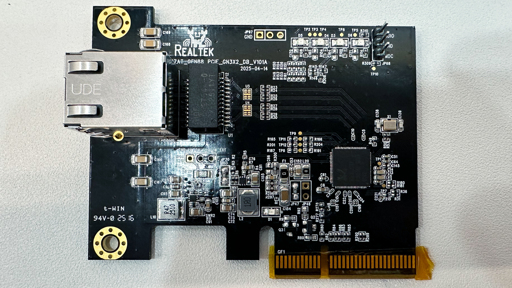This is going to be a huge help for home video editors.
but home Internet is still stuck at Gigabit speeds… and only in some cases are they maybe letting you go to 2 Gb. Wasn’t there that post floating around lemmy a while ago about how China can potentially give everyone like 5Gb for home or something? Can’t find it now but swore it was here…
That depends on where you live. I could get 10 Gbit/s WAN if I wanted to pay the subscription for that but 500 Mbit/s is enough.
Also 10 Gbit/s is mainly useful for LAN. Like connecting to a NAS.
I don’t disagree with that. There is almost no benefit to having residential Internet go beyond even 2Gb. Most people don’t realize that or are not shown why and so immediately figure that a bigger number means better experience. I use a 10Mb LAN connection to my Giagabit router at home and the only time I really suffer is when downloading huge files but I end up doing so in the background anyway…
I use a 10Mb LAN connection to my Giagabit router
Is that a 10BASE-T connect over two pairs of twisted pair? But even then you’d naively expect Fast Ethernet 100 Mb/s at least. I’m curious what it’s only 10, can you tell us?
as if more than .005% of computer users will actually be able to see any difference whatsoever.
I am just wondering if it would be better to go straight to fiber instead of ethernet as most have fiber to the home anyway. That should help with future speed upgrades beyond 10Gbit as well.
Fiber is also more power efficient? Why not?
I don’t think “most” have fiber to the home, first of all. Cable companies in the US do multigig speeds via fiber to a relay and coax cable to the home. Fiber is great when it’s underground or in a data center and safe, but it is delicate and easy to break the cables so not a great home solution. Fiber terminations are difficult and more expensive. The power efficiency payoff on a 1m cable from your router to your pc is probably going to be measured decades, more if you factor in the higher cost of the cable.
I have fiber directly into my house. My PC is on the opposite end from the modem. This comment is a load of baloney
Recognize that your situation is not like most people. Old apartment buildings especially will not be keen to run fibre everywhere when coax can handle gigabit speeds just fine
An SFP+ single mode module alone costs ~20€ at least. Add to that a PCIe extension card and you’re way over the cost of copper.
Add to that, that most homes have multiple devices that you want connected. So you need a fiber switch as well. 150usd will get you a mikrotik crs305, with 4 sfp+ ports. And you’ll probably want a router, but perhaps you can offload that to your ISP, kinda like routing on a stick.
You need more than10Gb/s at home? I mean we all know the 640Kb meme but I’m curious here :-)
I frequently transfer data over the LAN at a higher rate than my internet connection.
Kinda wish it was easier to test the connection speed between devices tbh, unless someone knows a good way of doing it but many devices are so locked down I am not sure how you would.
Even when doing that, the bottleneck is the storage write speed. you can have 1Tb internet connection and it wouldn’t matter unless you have enough users in a home.
Not all data transfer is sending stuff to storage, streaming your display live at a high bitrate for example never needs to go into storage.
Is more than 1Gbps needed for that? That seems insane, but I’m old and watch stuff in full HD so what do I know.
Low latency means low compression. Low compression means high bandwidth.
1080p60 NDI will be 200mbps. If you are doing 2160p60, that’s 800mbps (which is about the limit I would run 1gbe at). Doesn’t leave much overhead for anything else, and a burst of other traffic might cause packet drops or packet rejection due to exceeding the TTL.2.5gbps would be enough.
But I see 2.5gbps and 5gbps as “stop-gaps”. Data centers standardised on 10/40gbps for a while (before 25/100 and 100/400) - it’s still really common tbh - so the 10gbps tech is cheap.
I don’t see the point in investing in 2.5/5gbps
NVMEs are claiming sequential write speeds of several GBps (capital B as in byte). The article talks about 10Gbps (lowercase b as in bits), so 1.25GBps. Even with raw storage writes the NVME might not be the bottleneck in this scenario.
And then there’s the fact that disk writes are buffered in RAM. These motherboards are not available yet so we’re talking about future PC builds. It is safe to say that many of them will be used in systems with 32GB RAM. If you’re idling/doing light activity while waiting for a download to finish you’ll have most of your RAM free and you would be able to get 25-30GB before storage speed becomes a factor.
That is true, given everyone uses good quality nvmes, which is not always the case, but honestly, 1Gbps fiber is enough for a home with multiple users. Even if, assuming the storage is not the bottleneck, unless you need often very large lan transfers, should be more enough with 1Gbps.
Anyway, I guess i’m sidestepping the initial topic. bottom line: cool cheap tech for companies, not so much for home users.
edit: wording
We don’t all have 1Gbps fiber though, but even without it I can still benefit from 1Gbps ethernei
About damn time. We got a boost every few years from 10 to 100 to 1000. Then we just… Stopped. Stagnated. It’s understandable why, for a good long time one gigabit was all anybody needed, 100 MByte/sec is pretty good even for a NAS.
Of course then fiber ISPs got in the game, now in a lot of places you can buy 7-8gbps as a consumer product. And even multi-gig, which was supposed to ‘fix’ this, really ended up being insufficient. You could make a salad argument that multi gig was a waste of time and we should have just started moving to 10 gig.
Unfortunately, 10 gig switches still carry a significant premium. But this will start to shake that up. Sooner the better.
100MB/s are frustrating for a NAS. SSDs have been common for a decade, and the old spinning rust storage in my NAS is still faster than the network can handle?
Ahhh. First world problems are always a great read
It’s… a technology community.
My 25 mbps isp speeds make me sad.
Australian too?
i mourn the loss of full fibre NBN
every
damn
day
… fuck the liberals
Early 2000s say hello
IIRC I had like 1Mbps around early 2000 (like 2004 maybe), and the thing was that it was “always on”, no need to beep boop bzrrr use the phone line (like blocking it).
Realtek are monsters of semiconductor creation.
Destroyed
- sound card industry
- network card industry
What’s next?
Oh please do printer interface.
Literally anyone else could have done this. They all chose not to. So fuck them.
I think they’re making a bit of a joke here. It’s just progress.
Right up there battling broadcom for worst.
Excellent!
Now if we can only teach realtek how pci device id’s work, so they don’t use revision id’s to control power management, and links silently don’t come up if your kernel driver doesn’t support it properly.
I know this was a decade ago, but yeah, I’m still pretty damn pissed.
It’s impressive that they got the power consumption down to less than 2 watts. I think this is the first 10GBASE-T NIC I’ve seen that doesn’t have a heatsink on it.
And they did it on Cat5e! I have a Cat5e “trunk” that I really don’t want to try to restring, but it’s a choke point that I’d like to upgrade from 1Ge. If only someone will build SOHO switches with it
Cat 5e has 8 wires just like any later standard. There’s nothing stopping you from trying a faster speed on it.
As soon as switches get affordable enough, I do plan to try.
But my data center is an assortment of Raspberry Pi and similar. I’m not going to buy some used enterprise switch with a roaring fan and huge electrical consumption to connect my quiet, efficient datacenter.
So far I only have two devices that can talk greater than 1G, it’s more the number of things that have to talk across that “trunk”
It is being pushed beyond its ratings, so there’s no guarantees that it will work. There’s no harm in trying Cat5e at higher speeds if it’s already installed, but don’t install it with the intention of using it at more than 2.5G.
Usually you’d be fine to use 5e for like 100ft 33m
1 or 2.5g sure, not 5 or 10.
Anecdotal, but I’m doing 10g over a 100ft 5e cable. It’s not technically supported, but it does work on short runs.
I’m hoping for the best I can get right now. 1G is the choke point and rated speed, but I’ll take anything better if I don’t have to restring that cable.
My fastest current devices are 2.5gE, but I mostly want to loosen the choke point
Can we finally get some affordable 10GbE switches too?
What about a cheap low power PC, like a thinkcentre, with a couple of these cards? Could double as a NAS, or is security barring that?
I’m not sure where security comes in for this, but that sounds like a reasonable build to me.
I was thinking about the switch most people have I guess, the xDSL “box” who doubles up as a gateway and protects from intrusion and so.
Right?! Most affordable 10G switches are SFP+ which requires a lot more research to make sure you get the right modules and cabling.
A lot of those modules would work fine if the companies didn’t fuck with their drivers.
The Linux ixgbe driver (for Intel 82598 and 82599 chipsets) was submitted with a whitelist for Intel SFP+ adapters. Linux devs added a module option to shut off the whitelist, and tons of stuff is perfectly compatible.
Just use DACs within the rack. Single mode fiber patches and SFP+ optics are also cheap and easy to find.
DACs are great, agreed. However try telling that to the guy next door. The reason ethernet got to be so popular was because of how familiar it was and similar it us to telephone wire. There were several other competing standards befofe ethernet won.
10GbE cards and switches help regular folk upgrade without needing to learn about DACs.
Always amazes me how few people seem to know about DACs. I use them extensively in racks. They’re inexpensive and easy to use.
Cisco c3850-12x48u is about $150 on eBay.
- 802.3bt (60watt) PoE on all ports
- 36x 1gig rj45 ports
- 12x 1/2.5/5/10gig rj45 ports
- Has a module slot that you can add 4x or 8x (8x is rare so expensive) 10gig sfp+
The main problem is the idle power consumption. About 150w with nothing plugged in.
Not to mention the fans volume.
what is “affordable” to you? there are $100-$300 10GbE switches out there.
I’d like something that can replace my dinky little unmanaged 16-port gigabit switch for less than $300. Right now The only things I can find in that price bracket have maybe 5 ports. I’d settle for something that can just do 2.5/5Gb on all ports.
That’ll be a while, there isn’t much push yet (1gbe is still pretty fast) and you can do 2.5 if you want to push, they’re basically starting to replace 1gbe with 2.5gbe as a drop in.
WiFi kind of screwed everything because it’s 90-95% of all user clients, so if wifi can’t handle the bandwidth, the bandwidth is considered ‘commercial’ and they charge you through the nose.
16x2.5gbe with a couple of 10gbe uplinks (a couple so you can either daisy chain, or connect 1 to another switch and another to a sever with 10gbe) would be amazing - that’d handle wifi on a single port and allow multiple devices to all use their full 2.5gbe
i’ve seen a couple with 5x2.5gbe and 2xSFP+, which i guesssssss is okay
I have a few 4x2.5gbe and 2x10gbe, and I think one is 8x2.5 + 1x10gbe.
Theyll get better, networking is actually easy to sku once you get going, they’ve just enjoyed the premiums till now.
And again, wifi was considered the main connector, which is why we got 2.5gbe in the first place, it fit 802.11ac and most of ax.
Wasn’t it Realtek who made 1GbE popular as well by making the cheap 8111 IC over two decades ago?
And fucked it up by releasing the 8169 with a stepping change that added power management.
The kernel driver didn’t know this, so links would silently not come up, and you wouldn’t know why till you googled and learned you had to rebuild your kernel for your new motherboard.
Great to (maybe) see 10GbE coming and the initial price sounds reasonable compared to currently avaipable 2.5G and 5G Realtek adapters.
Apparently Linux 6.16 will have the driver included.
https://www.phoronix.com/news/Linux-6.16-Realtek-RTL8127ARealtek itself has demonstrated its RTL8127 NIC working with an unknown switch using cheap CAT5E cables, and the company’s representatives at the booth emphasised this fact. However, we do not know which switch or router the company used. Yet, most 10GbE routers and switches are designed for CAT6 cabling.
Funny update about the cabling they used during the demo. There’s really no reason Cat 5e couldn’t work for short enough distances with little interference. It’s more about the guaranteed minimum distance you can get, 55m with Cat 6 and the full 100m for any rating beyond that.
At least it’s not Marvell. But, man, can we pay another 17c and get … I guess not Broadcom as they’re waxing seriously dinkish, but who else?
Intel is probably still the gold standard. I’d pay a few bucks more to have something much more reliable.
Intel is probably still the gold standard.
I guess you’re not familiar with the i225-v and its variants. Intel burned their reputation for good NICs with that fiasco.
That’s too bad. I had a recent bad experience w/ a WiFi card, and I hoped that was a one-off since it was a budget chip. But you and someone else brought up more recent examples, so maybe Intel has lost its NIC crown.
Who should we look to now? I just want a solid NIC on Linux.
The Realtek RTL8125B on my year-old motherboard has been doing fine with Linux’s r8169 driver.
I’ve only used it at 1gbit/second, though; I haven’t tested its 2.5gbit mode.
Ever since the BE200 debacle I don’t know if I can trust Intel to deliver. Sure, the stuff that’s already out there works but who knows if any of their future stuff will?
They’re apparently in talks to sell off their network division. Future there is really up in the air.
Yeah, I had a bad experience with one of their other budget WiFi chips too. Maybe their hardware is getting worse, but they at least provide decent drivers.
Serious question: What do you use a 10GbE adapter for? Are there ISPs which offer 10gigabit bandwidth? I suppose it would be useful on a LAN
edit:

Yeah, imagine a network backup system that could actually back up your 20 TB media center in a few hours rather than several days.
Bro, tell that my German table first.
E.g., NAS on my LAN, especially for streaming high res video to devices in my house.
you’re streaming over a Gb worth of video? even a full 4k blu ray rip is less than 1/10 of that.
Well, no I’m not. You’re right. I miscalculated how much data was needed for video streaming. Even multiple simultaneous hi-res streams should stream fine with 1GbE.
But as an abstracted idea, you might want high throughput within your LAN for some reaosn, even if an ISP doesn’t offer 10Gbps to your house.
I want it cause number is higher…
File transfers between devices is one reason. With NVME R/W speeds you can easily saturate 1Gb networking equipment. I think 10Gb is more than most people need most of the time but it would still be nice to have if it weren’t so expensive. I just bought a small 2.5Gb switch to connect my server and PC together since both have 2.5Gb NICs and that seems to be a happy medium.
My gigabit connection is good enough for my NAS, as the read speeds on the hard drive itself tend to be limited to about a gigabit/s anyway. But I could see some kind of SSD NAS benefiting from a faster LAN connection.
If you shell money out for a full-flash NAS, you have the money to buy the bandwidth easily by the truckload.
Old meme is old. I’m in Central Wyoming with reasonably priced 2Gb/s FTTH and I could order 10Gb/s if I wanted it.
LAN for sure.
There are multiple ISPs that offer 10Gbps Internet service in Japan and South Korea, I imagine other densely populated cities might have them also. There is also the Swiss ISP that offers 25Gbps Internet service since 2021.
Though I agree it is probably more used for LANs.
Example of an ISP providing 10Gb/s in Portugal here and at 15 euros a month it’s pretty cheap too.
That same ISP is from Romania and is also in Spain though curiously in this latter their Net Only 10Gb/s subscription costs €25 per month,
Personally I don’t see the point of it for myself at home, but for a small business I can see it making sense.
ISPs in Switzerland offer up to 10 or 25Gbit over fiber.
https://www.init7.net/en/internet/fiber7/
But even within a LAN it really allows using a NAS for anything, not just slow access data.
8gbps here in USA… Quantum fiber.
I know of a few others in my area as well… Google Fiber, AT&T is offering 5gbps I think… Wyyerd is a local-ish one that’s offering 8gbps…
In the Netherlands there’s a few ISPs offering 4Gb and one even 8Gb iirc. Personally can’t really think of a use case for that though.
Realistically with my 1Gb connection, it’s always the outside restricting speeds. I seem to get the speed I pay for but every download or stream is throttled
Steam downloads consistently saturate my 1 Gbps connection, but it’s still fast enough for me. Had it a year now, still not really used to things going that fast.
I connect my primary and backup servers on 10G directly via a crossover cable for transferring ZFS snapshots. No actual 10G switches or anything at the moment but if I add any more servers I need to back up I’ll probably get a small 10G switch to put in between.
I’m backing up my physical media so I pretty regularly move hundreds of GB around. That would take forever on a 1G network.
I also take a ton of GoPro video(skydiving/motorcycle). An hour of 360 footage is ~50GB. So just moving that around is cumbersome.
I have a 5G fiber connection and even my wireless access point(AP) is 10G. Sure, you can’t get that to a single device(WiFi) but my phone connects at 2.4G up/down. So ~3 modern phones downloading games or whatever has the possibility to saturate my internet connection. They could saturate the AP by downloading media from my backups for offline playback for a flight or whatever.
My ISP (Bouygues, in France) offers 8Gbps at no additional cost over 1Gbps.
Realtek, don’t they have issues with drivers in FreeBSD? Or am I horribly out of date.
In any case I’m excited, even if i barely tap into 1gbe capability most of the time.
Realtek Freebsd drivers are ‘ok’ now, but that was a long fight.
Outside of wifi (I mean Jesus christ) most of freebsd networking got fixed a decade ago, but you still need to stick with common-ish gear.
Freebsd on kvm though, that’s a game breaker, especially with sriov mellanox.
Not sure if they provide official drivers for FreeBSD. Intel is usually a safer bet in that case.
To make use of a 10Gb network, wouldn’t I also need all of my equipment in between things to support 10Gb? Where am I supposed to get a 10Gb modem for residential use?
modem
You don’t need 10GbE WAN to make use of it on your LAN. If you have a lot of internal traffic (self hosting, for example), you really just need an internal router and some switches to support it. It’s more convenient to have your modem be your main router, but that’d not necessary.
I think that these just aren’t for me. I’ve considered upgrading my gear to 2.5Gb from 1Gb, but it just doesn’t feel worth it to me. Maybe in ten years when everything’s cheaper and more accessible.
If everything is constrained by your internet connection, it’s probably not worth it.
This will help within your home network, such as with a file server or vm host, large video files. Not everyone fits those use cases
I don’t fit those use cases either, but I want to
I do, but honestly anything past gigabit is overkill currently. My fileserver currently works over WiFi, and 100-200mbps is still plenty fot 1 UHD stream. Faster is always better, but 2.5gbps would already be overkill for what I need, so the extra cost of 10gbps isn’t needed.
That said, it’s feasible to get a 10gbps LAN today. Regular cat6 should be totally fine, and it’s pretty inexpensive.
3~5Gbps fiber is readily available in a lot of places. And some of us have internal networks with network attached storage and various servers running locally.
I have a NAS and servers as well. Do you have a router separate from your modem that these pass through?
Do you have a router separate from your modem that these pass through?
I’m not them, but I do. I like that my ISP does not have any equipment on my internal network.
I have a separate switch if that’s what you mean.
Also the NAS has 10Gbe already, I could have that plugged directly to my desktop for faster transfers until I get a 10Gbe switch.
Point being, 10Gbe at home isn’t that far fetched. I’ve had Gbe for what? 20 years?
So you have NAS to switch, switch to PC? And then that switch goes to the router/modem?
Correct
Thanks, I’ll have to consider this setup.
I use 10GbE for my internal network for my Ceph cluster. I’ve come about 80% of theoretical maximum for brief spikes from my NVMe drives rebalancing (mostly HDDs, few SSDs, couple NVMes).
Last part that I need is for SSDs to come down in price to where ~80TB isn’t too ridiculous (that’s 40TB usable space with RAID1). Cut the price per TB in half two more times to make it there. Otherwise, spinning platters are the bottleneck with my 10Gb network.
Which probably would have happened in the next few years if not for tariffs.
Even without tariffs, the collusion between nand manufacturers to keep prices high meant 2030 would be the earliest that 8tb SSDs would be “affordable”
Where am I supposed to get a 10Gb modem for residential use?
There are a few routers that have SFP+ slots so you can modulate to any laser signal your provider might require.
- FRITZ!Box 5690 Pro
- Zyxel AX7501
- TP-Link Deco BE85
Otherwise if you’re looking for strictly only a modem there are various available. They are usually simply called fiber to ethernet converter. Startek, Delock, Trendnet, FS
If you meant a switch, well 10G switches are abundant. Zyxel, Netgear, TP-Link all the usual suspects.
Even with the sfp+ ports some providers make not using their provided modem a real headache. (Looking at att)
In my experience that’s usually the case for XG-PON and XGS-PON networks. Because you’re sharing one port on the OLT with up to 63 neighbours. Though I think most build outs aim for 16 or 32 splits.
Anyway they don’t want to risk you sending when it’s not your turn or disturbing your neighbours connection in any other way, they make you use their ONU. Basically the same old story like with the coax cable modems. Just because some idiot (or rather industry group of idiots) had to go and turn fiber back into a shared medium to save on cable and ports a bit.
















